1. Suppose there are two Vue components, index.js in the src/router folder
import Vue from 'vue';
import Router from 'vue-router';
import officeHome from '@/view/officeHome';
import home from '@/view/home';
Vue.use(Router);
export default new Router({
routes: [
{
path: '/officeHome',
name: 'officeHome',
component: officeHome
},
{
path: '/view/home',
name: 'home',
component: home
}
]
});2. Implement simple route jump ------ program (router.push(...))
Use router.push to navigate to different URLs. Router.push will add a new record to the history stack, so when the user clicks the browser Back button, he will return to the previous URL.
<template>
<div>
<el-button type="primary" @click="pushTo1">Button 1</el-button>
<el-button type="primary" @click="pushTo2">Button 2</el-button>
<el-button type="primary" @click="pushTo3">Button 3</el-button>
<el-button type="primary" @click="pushTo4">Button 4</el-button>
</div>
</template>
<script>
export default {
name: 'officeHome',
data () {
return {};
},
methods: {
pushTo1 () {
// path by default
this.$router.push('/view/home');
},
pushTo2 () {
this.$router.push({path: '/view/home'});
},
pushTo3 () {
this.$router.push({name: 'home'});
},
pushTo4 () {
// In case of both name and path, name shall prevail
this.$router.push({name: 'home', path: '/view/home'});
}
}
};
</script>
In the above four ways, click to realize route jump. After jump, route address:

3. Program (router.push(...) ------ query parameters
Vue component: officeHome
<template>
<div>
<el-button type="primary" @click="pushTo1">Button 1</el-button>
<el-button type="primary" @click="pushTo2">Button 2</el-button>
<el-button type="primary" @click="pushTo3">Button 3</el-button>
</div>
</template>
<script>
export default {
name: 'officeHome',
data () {
return {};
},
methods: {
pushTo1 () {
this.$router.push({path: '/view/home', query: { username: 'liu', userId: 12 }});
},
pushTo2 () {
this.$router.push({name: 'home', query: { username: 'liu', userId: 12 }});
},
pushTo3 () {
// In case of both name and path, name shall prevail
this.$router.push({name: 'home', path: '/view/home', query: { username: 'liu', userId: 12 }});
}
}
};
</script>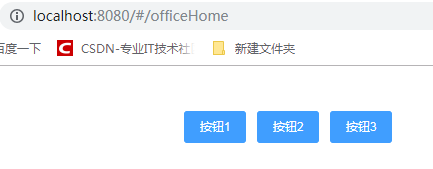
Vue component: home
<template>
<div>
<p>user name:{{user.username}}</p>
<p>ID: {{user.userId}}</p>
</div>
</template>
<script>
export default {
name: 'home',
data () {
return {
user: {
username: '',
userId: ''
}
};
},
mounted () {
// $router is a VueRouter instance. Navigate to different URL s and use $router.push
console.log(this.$router);
// $route is the current router jump object. You can get name, path, query, params, etc. through $route. Attribute name
console.log(this.$route);
console.log(this.$route.query);
this.user = this.$route.query;
}
};
</script>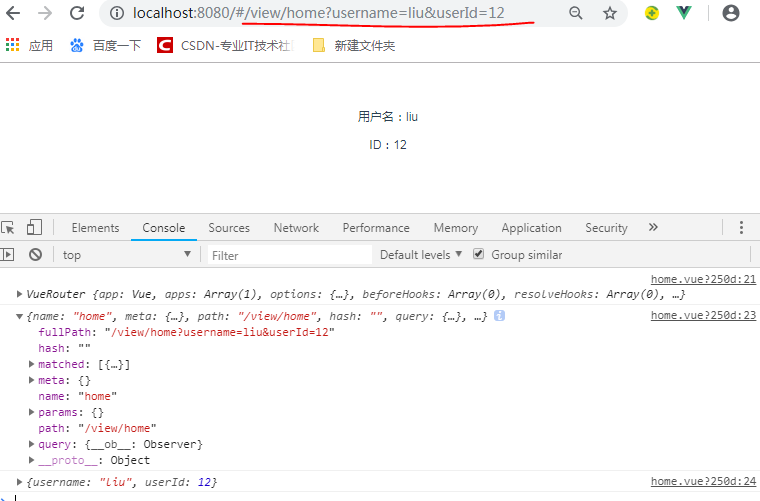
Note: using query to pass parameters, the parameters will be displayed in the route (/ view / home? Username = Liu & userid = 12)
4. Program (router.push(...) ------ params parameter, specify route name
Vue component: officeHome
<template>
<div>
<el-button type="primary" @click="pushTo1">Button 1</el-button>
<el-button type="primary" @click="pushTo2">Button 2</el-button>
<el-button type="primary" @click="pushTo3">Button 3</el-button>
</div>
</template>
<script>
export default {
name: 'officeHome',
data () {
return {};
},
methods: {
pushTo1 () {
// This kind of path that specifies the route and does not specify the name of the route will cause params to fail
this.$router.push({path: '/view/home', params: { username: 'liu', userId: 12 }});
},
// Using params to pass parameters, you must specify the name property of the Vue component route
pushTo2 () {
this.$router.push({name: 'home', params: { username: 'liu', userId: 12 }});
},
pushTo3 () {
// In case of both name and path, name shall prevail
this.$router.push({name: 'home', path: '/view/home', params: { username: 'liu', userId: 12 }});
}
}
};
</script>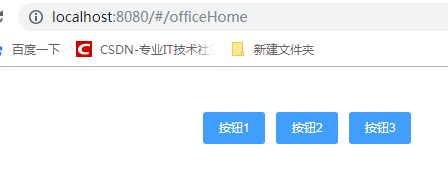
Vue component: home
<template>
<div>
<p>user name:{{user.username}}</p>
<p>ID: {{user.userId}}</p>
</div>
</template>
<script>
export default {
name: 'home',
data () {
return {
user: {
username: '',
userId: ''
}
};
},
mounted () {
// $router is a VueRouter instance. Navigate to different URL s and use $router.push
console.log(this.$router);
// $route is the current router jump object. You can get name, path, query, params, etc. through $route. Attribute name
console.log(this.$route);
console.log(this.$route.params);
this.user = this.$route.params;
}
};
</script>Click button 1 to jump. The resulting params is an empty object
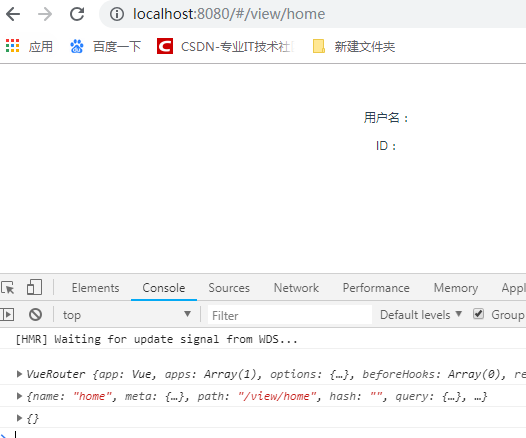
Click button 2 and button 3 to jump to get the parameters passed through params
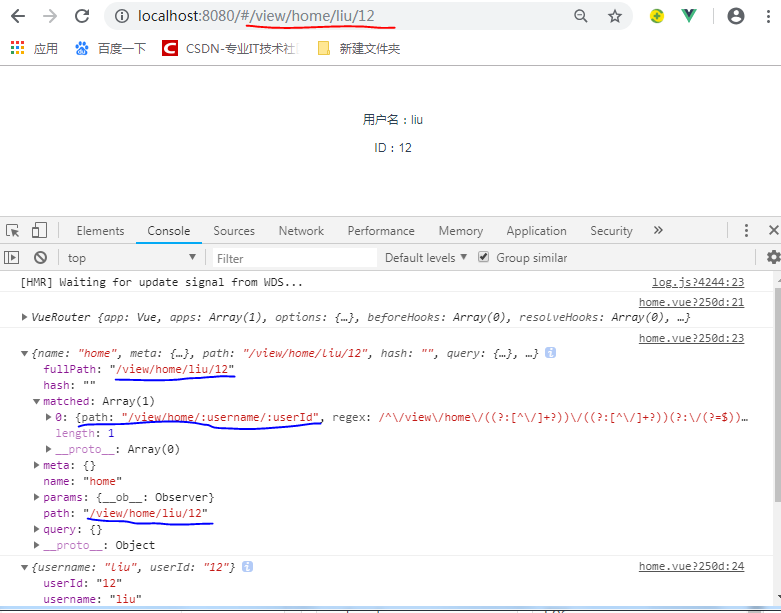
By specifying the name of the route and using params to pass parameters, the parameters will also be displayed in the route (/ view/home/liu/12)
5. Program (router.push(...) ----- params parameter, handwritten complete route
In the route configuration file of the project, the route of the configuration component home is changed as follows:
{
path: '/view/home/:username/:userId',
name: 'home',
component: home
}Vue component: officeHome
<template>
<div>
<el-button type="primary" @click="pushTo4">Button 4</el-button>
</div>
</template>
<script>
export default {
name: 'officeHome',
data () {
return {};
},
methods: {
// Use params to pass parameters and write complete path with parameters
pushTo4 () {
const username = 'liu';
const userId = '12';
this.$router.push({path: `/view/home/${username}/${userId}`});
}
}
};
</script>
Vue component: home
<template>
<div>
<p>user name:{{user.username}}</p>
<p>ID: {{user.userId}}</p>
</div>
</template>
<script>
export default {
name: 'home',
data () {
return {
user: {
username: '',
userId: ''
}
};
},
mounted () {
// $router is a VueRouter instance. Navigate to different URL s and use $router.push
console.log(this.$router);
// $route is the current router jump object. You can get name, path, query, params, etc. through $route. Attribute name
console.log(this.$route);
console.log(this.$route.params);
this.user = this.$route.params;
}
};
</script>
Click the button to jump to get the parameters passed through params

Through handwritten complete route and params, parameters will also be displayed in route (/ view/home/liu/12)